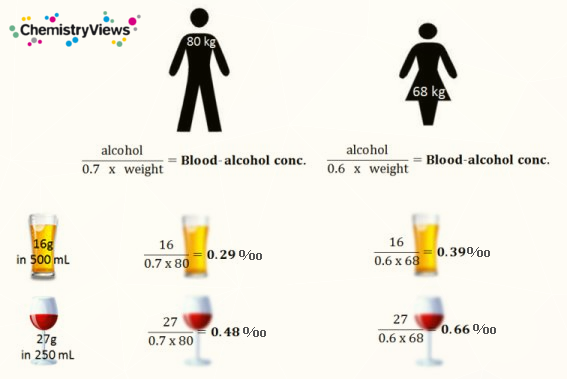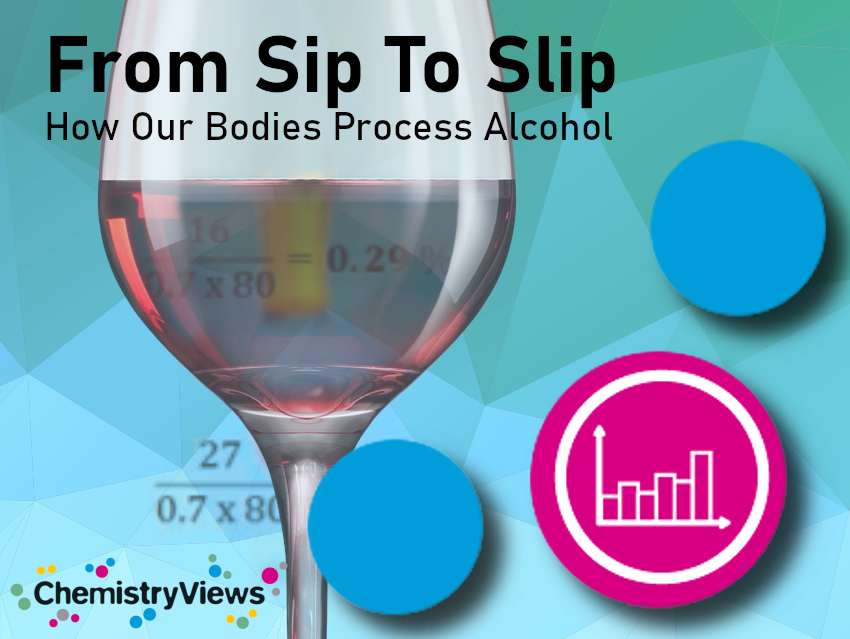Most of us have enjoyed a glass of champagne to celebrate a special occasion, a beer to relax after a hard day of work, or a glass of wine to accompany a nice meal. But what happens to this alcohol once it has been consumed?
1 The Widmark Formula
Calculating the Blood-Alcohol Concentration


2 Blood-Alcohol Concentration Over the Course of an Evening

Source: [1]
3 Metabolism of Ethanol

Source: [2]

4 Percentage of the Population with Inactive Aldehyde Dehydrogenase

Source: [3]
References
[1] Klaus Roth, Chemistry of a Hangover — Alcohol and its Consequences, ChemViews Magazine 2011. DOI: 10.1002/chemv.201000074
[2] Klaus Roth, Chemistry of a Hangover — Alcohol and its Consequences Part 2, ChemViews Magazine 2011. DOI: 10.1002/chemv.201000078
[3] Klaus Roth, Chemistry of a Hangover — Alcohol and its Consequences Part 3, ChemViews Magazine 2011. DOI: 10.1002/chemv.201000089
Also of Interest

We look at the chemistry behind breathalizers and their development since 1931





In the capital of Spain, Madrid, held the 3rd World Congress of Preventive Medicine and Patient Safety, organized by the International Association for Risk Management in Medicine (IARMM) http://www.iarmm.org/, international scientific meeting that included doctors from different specialties and specialists in health management care patients hospitalized in a medical center. Congress Organizing Committee included, along with Congress President, Ryoji Sakai (President Congress IARMM. Dr. Med. Hon. Prof. SU, former Prof. TWU, EPFL, USM, etc., Japan), Allen J Vaida (IARMM Advisor, Dr. Executive Vice President, the Institute for Safe medication Practice, USA), Aidan Halligan (Prof. MD University College London, Brighton and Sussex University Hospitals, UK), and professors of medicine were doctors from 55 countries from all continents. From Romania, the major organizer of the Congress has been nominated by the Staff IARMM, Dr. Aurelian Udristioiu, Member of the National Academy of Clinical Biochemistry American (NACB), Washington DC in 2005, Physician Director, Laboratory, Emergency County Hospital Targu Jiu. this section, a recorded high audience has had the work of the authors, Dr. Aurelian Udristioiu, Laboratory Director, County Emergency Hospital Targu Jiu and Prof. PhD Dr.Manole Cojocaru, Faculty of Medicine Titu Maiorescu, Department of Physiology, Bucharest, Romania, with the title “The effects of alcohol on liver function of exogenous and endogenous.” The authors point out that liver disease in 2013 was the 12th leading cause of death in the United States, annual deaths being reported, the number of 27,000 cases, statistically from the Centers for Disease Control and Prevention, USA. In Western countries, up to 50% of cases of end-stage liver disease are alcohol as an important etiologic factor. Alcoholic cirrhosis mortality is higher than that of non-alcoholic cirrhosis, with a survival rate at 5 and 10 years of only 23% for men and 7%, respectively, for women. Romania is on par with Portugal on the number of cases of cirrhosis is irreversible form of liver disease that occurs in about 30% of excessive drinkers. This form of cirrhosis occurs in men who consumed large amounts of alcohol per day (> 100 mg alcohol 40%) for 10-15 years and for women, in less than seven years. Total bilirubin (5.6 mg / d L mean, SD = 0.04), prolonged prothrombin time (PT) [INR = 4.53 average, SD = 1.63], thrombocytopenia <100 / mm³ platelets SAGE and hypo-albuminemia in peripheral (1.2 mg d / l, the mean SD = 0.083) are markers of severe alcoholic hepatitis and / or cirrhosis. Laboratory research showed that the enzyme alcohol dehydrogenase (ADH) is an enzyme that makes it possible for people to drink beer, wine and other alcoholic beverages. However, its function “real” is considered to convert alcohol generated by bacteria in the intestines, in other metabolic products (acetaldehyde). People with certain mutant forms of ADH (mRNA-155) may be particularly sensitive to alcohol, compared to healthy individuals. The new research in this area has revealed that alcohol could be produced naturally in the body, hence the term syndrome to install “auto-brewery” in patients with intestinal infections, especially with the bacteria Gram negative antigen lipopolysaccharide (LPS), responsible for the initiation of liver fibrosis in Kupffer cells (TLR-4 receptors). For example, yeasts such as Candida albicans in vitro production of ethanol. These people atypical endogenous ethanol could eat products after carbohydrate-rich foods. A particular genetic polymorphism resulting in reduced activity of enzymes involved in hepatic metabolism of ethanol may explain ethnic differences in rates of endogenous ethanol production. Yet people healthy prospective studies confirm that moderate wine consumption is associated with elevated plasma concentrations of omega-3 polyunsaturated fatty acids reduce blood viscosity, improve insulin sensitivity, decrease platelet aggregation and beneficial changes in plasma coagulation proteins, increases HDL (good) cholesterol, and increase cardio-protective effect by 50%. At the end of the paper highlighted that between alcoholic drinks, red wine, with a variety of polyphenols, including phenolic acids, tannins, resveratrol (a powerful antioxidant) and flavonoids appear to have significantly higher antioxidant, and anti-carcinogenic and is anti-inflammatory drugs, in contrast to the gin (ethanol free polyphenols), and ethanol abuse, cancer effect. Dr. Aurelian Udristioiu, M.D > > > Lab Director, > > > City Targu Jiu, Romania > > National Academy of Biochemical Chemistry > > American NACB Member, Washington D.C, USA.